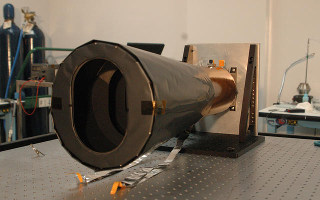
The Context Camera (CTX) is a camera on board the Mars Reconnaissance Orbiter (MRO) acquiring grayscale images at 6 meters per pixel scale over a swath 30 kilometers wide. CTX provides context images for the MRO HiRISE and CRISM observations, is used to monitor changes occurring on the planet, and acquires stereo pairs of selected, critical science targets.
Data description
The following CTX products are available on MarsSI:
- EDR image: Raw image in a standard format called the Experiment Data Record
- RDR image: Converted raw image into reflectance (irradiance/solar flux or I/F) called Radiometric Data Record
- MRDR image: Projected image from RDR image
- EDTM image: CTX DTM not aligned to MOLA data
- ALEDTM image: CTX DTM aligned to MOLA data
The CTX files have names like P16_007430_1783_XN_01S083W.
Downloading and processing CTX data
CTX Imagery
The pipelines used for the data calibration and projection are those proposed by ISIS3 (https://isis.astrogeology.usgs.gov/index.html).
From the “Maps” tab, zoom-in on your region of interest, you can display the THEMIS mosaic for more precision, and then display the CTX layer. You get all CTX stamps that appear in green. The stamps are regularly updated to take into account new data. You can use the “Select” button to choose the stamp you desire. You can choose several stamps by clicking several stamps, or by dragging your mouse to select adjacent stamps. You can also use the “Search” button for more options.

To add your desired stamps to your cart click on “Add” in the “Cart” window, and go to the “Workspace” tab. Your CTX image appears in the window “Data to process”. If not, you may already have processed it yourself, or someone else may have processed it, then it may already be in the “Data processed” window. If the image has not been processed, you will have to go through several steps:
- Download the CTX EDR image (rawdata) to the MarsSI server by clicking on the EDR image and the “Process” button in the “Data to process” window. This will take a few minutes.
- When the first step is done, you can create a calibrated RDR image: click on the proposed RDR image in the “Data to process” window and on the “Process” button. This will take another few minutes, depending on the length of the CTX observation.
- Project the CTX image by processing the proposed MRDR image in the “Data to process” window. This will take more time than the previous processes, another few minutes.
When these different steps are done, the MRDR image is waiting for you in the “Data processed” window and you can copy it to your FTP partition.
Digital Elevation Models
In order to realize a CTX DEM, you must have proceeded through all the CTX imagery processing steps, described in the previous section.
The CTX DTM images created by MarsSI are generated using the NASA AMES Stereo Pipeline (http://ti.arc.nasa.gov/tech/asr/intelligent-robotics/ngt/stereo/).
From the “Maps” tab, zoom-in on your region of interest, you can display the THEMIS mosaic for more precision, and then display the CTX stereo layer. You get all areas where MarsSI proposes to compute a CTX DTM, appearing in yellow. The stamps are regularly updated to take into account new data. You can use for example the select button to choose the stamp you desire.

To add your desired stamps to your cart click on “Add” in the “Cart” window: you can notice in the “Cart” window that three data were added, the two overlapping EDR images that will be used, and the EDTM file that will be computed. Then go to the “Workspace” tab.
The EDTM stamps have been created automatically based on the percentage of intersection and the difference in emission angle between the two EDR images. Please be advised that EDTM stamps mean only possible DTMs: a viewing validation of the EDR images should be performed from the PDS’s link available in the footprint attribute. Atmospheric clouds for example can prevent the DTM calculation.
Your CTX images and DTM appear in the window “Data to process”. If not, you may already have processed it yourself, or someone else may have processed it, then it may already be in the “Data processed” window. If the images have not been processed, you will have to go through several steps:
- Download the CTX EDR image (raw data) to the MarsSI server and create a calibrated RDR image as described previously.
- Create the DTM by processing the proposed EDTM data in the “Data to process” window which may take few hours, depending on the length of the overlapping images.
- Process the proposed ALEDTM data in the “Data to process” window to align the CTX DTM to the MOLA data. This last step should only take few minutes.
When these different steps are done, the ALEDTM is waiting for you in the “Data processed” window and you can copy it to your personal data directory.
Additional information about AMES Stereo Pipeline products can be found in: http://byss.ndc.nasa.gov/stereopipeline/binaries/asp_book-2.5.0.pdf
References
- CTX instrument description website: http://www.msss.com/all_projects/mro-ctx.php
- CTX instrument description paper: Malin et al., (2007), Context Camera Investigation on board the Mars Reconnaissance Orbiter, Journal of Geophysical Research, 112, E05S04, doi: 10.1029/2006JE002808.
